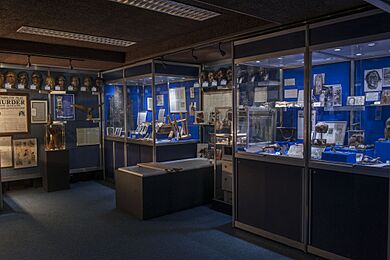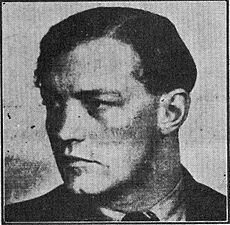Crime Museum facts for kids
The Crime Museum is a special collection of items linked to crimes and investigations. It's kept at New Scotland Yard in London, which is the main office for the Metropolitan Police Service. For a long time, until the early 2000s, it was known as the Black Museum.
The museum started around 1874. Police officers began collecting items from prisoners and crime scenes. The idea was to help police learn more about how crimes happen and how to prevent them. At first, it wasn't an official museum, but by 1875, it became one. A police inspector and a police constable were even assigned to work there full-time.
The museum has never been open to the general public. It was mainly used to teach new police recruits. Only people involved in legal matters, royal family members, and special guests could visit. Today, the museum is in the basement of the Curtis Green Building, which is the current New Scotland Yard. It's still closed to the public, but police officers from across the country can visit by making an appointment.
Contents
History of the Museum
How the Museum Started
The idea for the Crime Museum came from Percy George Neame, a police inspector, in 1874. He started gathering items to help teach police officers how to solve and prevent crimes. Some of the very first items on display were clothes and belongings of Jane Clouson, a 17-year-old girl who was murdered in Eltham.
By late 1874, the police officially approved the idea of opening a crime museum. Inspector Neame, with help from a police constable named P.C. Randall, collected enough items from old and new cases. Many of these first items were things found with burglars and thieves. The exact date the Black Museum opened in 1875 isn't known. However, Neame and Randall were officially assigned to the Prisoners Property Store on April 12, 1875, which suggests the museum opened later that year.
The museum didn't have a grand opening. In its first two years, many visitors came, especially detectives who used the museum as part of their training. This meant the museum was always in use. Records of visitors weren't kept until October 6, 1877. On that day, important guests were given a tour by high-ranking police officials. These were the first names in a visitor book that was used until 1894. Many famous people signed it, though not everyone was asked to. A reporter from The Observer newspaper was not allowed in by Inspector Neame. On April 8, 1877, this journalist gave the collection its famous name: 'Black Museum'.
Museum Moves and Exhibitions
In 1890, the museum moved with the Metropolitan Police office to a new building called New Scotland Yard. This building was located on the Thames Embankment. The museum was set up in rooms in the basement. P.C. Randall was in charge of keeping it tidy, adding new items, and arranging visits. Inspector Percy Neame retired in 1901.
The museum was closed during both World War I and World War II. In 1967, New Scotland Yard moved again to Victoria Street. The museum was then housed on the second floor and was updated several times.
While the current New Scotland Yard building was being renovated, many items from the museum were shown to the public for the first time. This special exhibition, called "The Crime Museum Uncovered," was held at the Museum of London from October 2015 to April 2016. After this exhibition, the museum reopened in 2018. It's now in a "dark and dramatic" room in the basement of the Curtis Green Building.
Even though the 2015–2016 exhibition was the only time so many items were shown to the public, some individual objects have been loaned to other museums. For example, items from the Great Train Robbery were shown at the Postal Museum. A special cigarette lighter from the Krogers case was displayed at the Science Museum. Also, items from the trial of Roger Casement have been on loan to Kerry County Museum since 2016.
What's in the Museum?
The museum has more than 500 items on display. Each item is kept at a constant temperature of 17 degrees Celsius (63 degrees Fahrenheit). The collection includes both very old items and more recent ones.
You can see many different kinds of weapons, some obvious and some hidden. All of these have been used in serious crimes in London. There are also shotguns disguised as umbrellas and many walking-stick swords.
The museum also has displays from famous cases. These include items that belonged to Charlie Peace and letters that some people believe were written by Jack the Ripper. However, the famous "From Hell letter" is not part of the collection. More recent items on display include the ricin-filled pellet that killed a Bulgarian writer named Georgi Markov in 1978. There's also a model of the umbrella that might have fired the pellet. Other items include a fake diamond from the Millennium Dome heist and items connected to the Dennis Nilsen case, such as a stove and a bathtub.
Some items not currently on display include things that belonged to Charles Black, who was known for making many fake banknotes. These include printing plates, fake banknotes, and a cleverly hollowed-out kitchen door he used to hide them.
Cases on Display (A-Z)
Here are some of the cases you can learn about in the museum:
- The uniform from the Death of Keith Blakelock case in 1985.
- The trunk from the Charing Cross Trunk Murder case.
- Items related to John Reginald Halliday Christie.
- Three guns from the 1944 cleft chin murder case.
- Thomas Neill Cream's kit (he was known as the Lambeth Poisoner).
- The revolver used in the Ruth Ellis case.
- Evidence from the February 1918 "Badge and Button Murder," also known as the Eltham Common murder.
- Items related to John George Haigh.
- A cast of the hole drilled into the vault wall during the Hatton Garden safe deposit burglary. In this 2015 case, thieves took many valuable items.
- Items from the Neville Heath case.
- Items related to Dennis Nilsen.
- The pistol used by Udham Singh.
- Evidence from the Stratton Brothers case. They were the first men in Great Britain to be found guilty of a crime based on fingerprint evidence.
The Museum in Books and Movies
The Crime Museum has inspired many stories in radio, comics, and films.
- In 1951, a radio series called The Black Museum was hosted by Orson Welles. Each week, the show featured an item from the museum and told the story behind it.
- Another radio show, Whitehall 1212, also featured stories from the museum. Its name came from the old telephone number for Scotland Yard.
- In the Judge Dredd comic strip, there's a fictional Black Museum inside the Grand Hall of Justice.
- The Dylan Dog comic series often mentions a fictional version of the Black Museum. In some stories, items are even stolen from it.
- The 1944 film The Lodger shows Inspector Warwick (George Sanders) giving a tour of the museum.
- A 1958 horror film called Horrors of the Black Museum also refers to the Black Museum.
- The fourth season of Charlie Brooker's Black Mirror has an episode called "Black Museum".
- Author Tony Parsons wrote about the Black Museum in his books about detective Max Wolfe.



